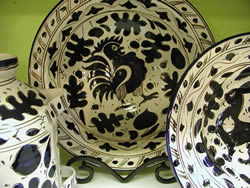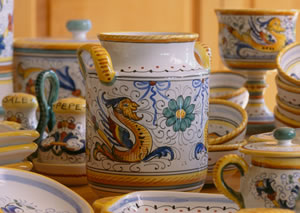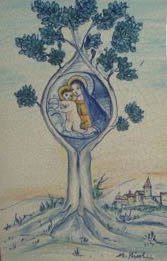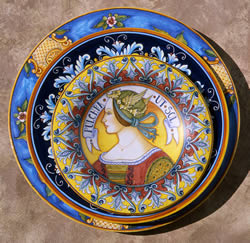The name “maiolica” (majolica) comes from the Spanish island of Majorca where ships carrying lusterware from Valencia stopped on their way to Italy. By the 1500s in Italy the term had broadened its’ meaning from lusterware to ‘tin glazed earthenware.’
 Italian maiolica was first produced around 1350. Maiolica is an Italian earthenware with an opaque white tin oxide glaze. Its most outstanding feature is the beautiful, colorful decoration which never fades or loses its beauty. Maiolica is usually associated with the Renaissance when it hit its aesthetic peak, but it had been produced in Italy since the 13th century and is still produced today.
Italian maiolica was first produced around 1350. Maiolica is an Italian earthenware with an opaque white tin oxide glaze. Its most outstanding feature is the beautiful, colorful decoration which never fades or loses its beauty. Maiolica is usually associated with the Renaissance when it hit its aesthetic peak, but it had been produced in Italy since the 13th century and is still produced today.
Early maioliche was decorated in just two colors: manganese–brown and copper-green. Between 1350 and 1460 improvements were made in kilns and glazes which established the polychrome decoration that is now associated with Renaissance ceramics.
 By the 16th century maiolica painters imitated frescos and oil paintings, aided by prints and book illustrations. They began decorating with scenes from classical history, the Bible and mythology. This type of decoration is known as istoriato or historiated maiolica. After the 16th century istoriato scenes were complemented around the ware’s rim or exterior by fanciful designs that came to be known as grottesche or grotesques. The word is derived from the rediscovery of the Golden House of Nero in Rome. Its underground chambers or grotte, were painted with these elaborate, whimsical motifs and the word stuck. Raphael’s use of grottesche in his paintings for the Vatican Loggie made them especially popular and they were, and continue to be, recreated in ceramic production. This pattern is widely know today as Raffaellesco.
By the 16th century maiolica painters imitated frescos and oil paintings, aided by prints and book illustrations. They began decorating with scenes from classical history, the Bible and mythology. This type of decoration is known as istoriato or historiated maiolica. After the 16th century istoriato scenes were complemented around the ware’s rim or exterior by fanciful designs that came to be known as grottesche or grotesques. The word is derived from the rediscovery of the Golden House of Nero in Rome. Its underground chambers or grotte, were painted with these elaborate, whimsical motifs and the word stuck. Raphael’s use of grottesche in his paintings for the Vatican Loggie made them especially popular and they were, and continue to be, recreated in ceramic production. This pattern is widely know today as Raffaellesco.
 By the end of the 15th century, small towns had become renowned for their high-quality maiolica and had developed distinct styles. Some were larger cities, such as Siena, but there was a tendency for them to be small towns whose market was a large nearby city to which they were politically affiliated. Two prominent examples were Deruta, near Perugia and Montelupo, near Florence. Both of these towns are located along the riverbanks where there are natural clay deposits, perfect for the production of maiolica – the Tiber in Umbria and the Arno in Tuscany. By the 16th century some of the maioliche towns developed export trade to the rest of Italy and Sicily and northern Europe. The popularity of Italian maiolica grew with inclusion in religious houses, pharmacies, secular building, tableware for the well-to-do and devotional objects. The church of Madonna dei Bagni near Deruta still has over 600 maiolica votives (plaques offered to the Madonna asking for saintly intervention), dating from the 17th century to the present.
By the end of the 15th century, small towns had become renowned for their high-quality maiolica and had developed distinct styles. Some were larger cities, such as Siena, but there was a tendency for them to be small towns whose market was a large nearby city to which they were politically affiliated. Two prominent examples were Deruta, near Perugia and Montelupo, near Florence. Both of these towns are located along the riverbanks where there are natural clay deposits, perfect for the production of maiolica – the Tiber in Umbria and the Arno in Tuscany. By the 16th century some of the maioliche towns developed export trade to the rest of Italy and Sicily and northern Europe. The popularity of Italian maiolica grew with inclusion in religious houses, pharmacies, secular building, tableware for the well-to-do and devotional objects. The church of Madonna dei Bagni near Deruta still has over 600 maiolica votives (plaques offered to the Madonna asking for saintly intervention), dating from the 17th century to the present.
 By the 17th century the demand for maiolica was in decline. Some of the older centers disappeared while new centers came to the fore, including Bassano in the north, Naples in the south and Palermo and Caltagirone in Sicily. The decorative styles of the Renaissance were often replaced by styles which harmonized with the fashion of the times. By the 18th century there was increasing competition from French and German Faience, Oriental and European porcelain (including Italian) and English creamware. During the early 19th century there was further decline in production, but by the middle of the century a renewal of interest in Renaissance art revived production of maiolica in Florence, Deruta and Faenza, to name a few places. This lasted for a few decades, but by the mid 1800s the Italian ceramic centers of maioliche suffered an acute market crisis brought on by an increased demand for porcelain or cheaper earthenware. The artistic and technical skills once prevalent in towns like Deruta were all but lost. Where there once were hundreds of maioliche workshops, by the 1850s only a handful were left.
By the 17th century the demand for maiolica was in decline. Some of the older centers disappeared while new centers came to the fore, including Bassano in the north, Naples in the south and Palermo and Caltagirone in Sicily. The decorative styles of the Renaissance were often replaced by styles which harmonized with the fashion of the times. By the 18th century there was increasing competition from French and German Faience, Oriental and European porcelain (including Italian) and English creamware. During the early 19th century there was further decline in production, but by the middle of the century a renewal of interest in Renaissance art revived production of maiolica in Florence, Deruta and Faenza, to name a few places. This lasted for a few decades, but by the mid 1800s the Italian ceramic centers of maioliche suffered an acute market crisis brought on by an increased demand for porcelain or cheaper earthenware. The artistic and technical skills once prevalent in towns like Deruta were all but lost. Where there once were hundreds of maioliche workshops, by the 1850s only a handful were left.
In Deruta in the 1880s to 1900 a movement was started to re-establish Deruta and other Umbrian towns to the forefront of maiolica design and production. In 1900 a ceramics museum was created to promote historical and cultural research. The museum was founded with the aim of serving the artists of Deruta and the history of Deruta. In 1903 the Communal School of Design was set up with the primary goal of training craftsmen in the traditional techniques. They wanted to recreate the antique and traditional types of production and imitate Renaissance styles. Due to the creation of the museum and school, Deruta today is one of the leading exporters of fine Italian maioliche.
There are some wonderful ceramic museums in Italy that show the progression of technical improvements and artistic skill. Check out these links:
In Tuscany, the Museo Montelupo
In Veneto, Le Ceramiche di Nove e Bassano
